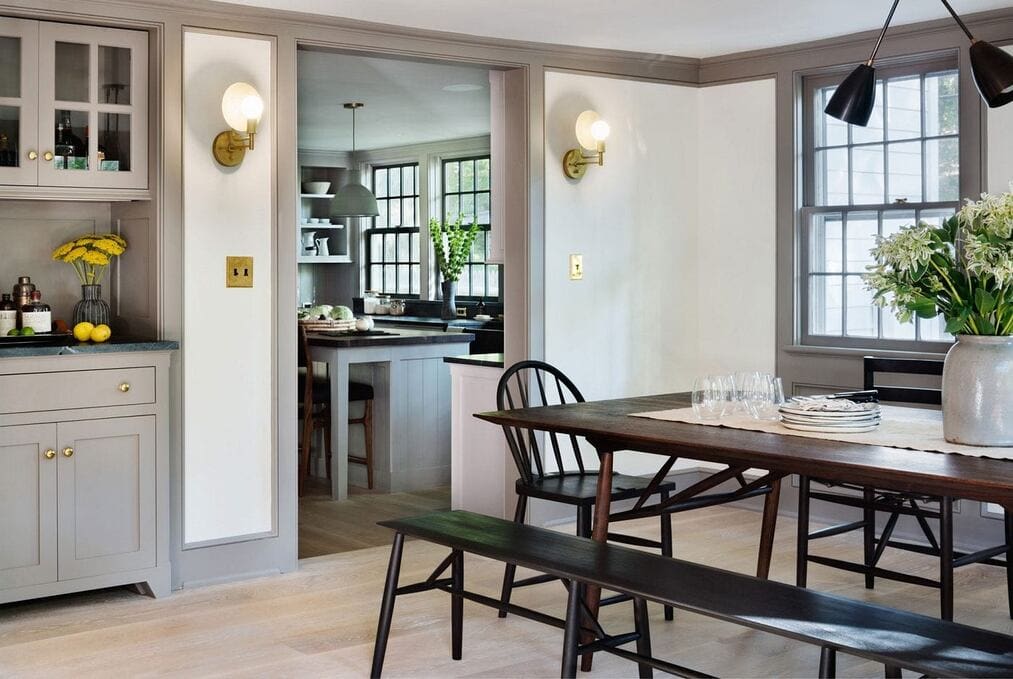How to Match New Paint With Existing Trim and Fixtures

Homeowners often want a fresh new wall color without replacing everything else in the room. But if your trim, cabinetry, flooring, or fixtures are staying, that decision gets more complicated. The wrong wall color can make everything around it look off or worse, outdated.
That’s why professionals take a very different approach to color selection when they’re working around existing elements. They don’t start with a trendy swatch. They start with what’s already in the room.
If you’ve ever wondered how to match new wall paint with existing trim, the key is understanding the relationship between permanent finishes and flexible color options. This guide explains how professional painters evaluate a space and use color theory to create a balanced, updated look that feels intentional, not improvised.
Start With What’s Staying: Identify Your Fixed Colors
Before selecting a new wall color, professionals begin by looking at what can’t be changed. These are the fixed elements in your home, the features that will remain even after the paint job is complete.
These include:
- Trim and molding
- Cabinets or built-ins
- Flooring (wood, tile, carpet)
- Countertops
- Hardware and light fixtures
Each of these surfaces has a color, a finish, and often an undertone. Since you’re not replacing these items, your new paint color must work with them, not against them.
A professional painter or color consultant doesn’t guess. They assess each fixed element and consider how it will interact with different types of wall color. That includes the natural and artificial light in the space, which can affect how the trim and fixtures appear throughout the day.
If you’re wondering how to match new wall paint with existing trim, the first step is making sure the trim’s tone and texture are fully understood. A crisp white with a cool undertone won’t pair well with a wall color that leans warm or creamy.
This kind of coordination takes experience. Professionals know how to spot subtle conflicts between finishes that might not be obvious at first but will stand out after the job is done.
Understand Undertones: The Hidden Color Clues
One of the biggest reasons wall color clashes happen is because of undertones. Most paint colors and materials have an underlying hue that subtly influences how they appear in different lighting.
This is where professional guidance makes a huge difference.
Trim might look bright white until you hold it next to a cooler gray wall, then suddenly it looks yellow. Natural wood floors may lean red or orange, which can throw off your entire palette if not addressed.
Here are some undertones professionals always look for:
- White trim can have blue, green, pink, or yellow undertones
- Wood flooring and cabinets often have red, orange, or golden tones
- Stone countertops may include flecks of gray, green, or brown
- Metal fixtures like bronze, chrome, or brushed nickel affect the color temperature
Matching new wall paint with existing trim isn’t about picking a trendy color. It’s about making sure the undertones of every element work together. Professional painters and color experts use this knowledge to eliminate clashing combinations before they ever hit the wall.
Understanding undertones isn’t something most people spot easily. That’s why color consultations with a professional are especially valuable when you’re keeping trim or fixed finishes in place.
Don’t Rely on Paint Chips Alone
Paint swatches are helpful, but they don’t tell the whole story. What looks perfect under store lighting can look completely different once it’s on your walls. Professionals know this, and that’s why they rarely choose a color based on a chip alone.
Lighting, surrounding finishes, and wall texture all affect how paint appears. Even the time of day can shift the look of a color. That’s why sampling is essential when you’re deciding how to match new wall paint with existing trim.
Here’s how professionals approach sampling:
- They use larger sample boards or painted sections, not just tiny swatches
- They test colors in multiple lighting conditions, both natural and artificial
- They compare test areas next to trim, cabinetry, and flooring, not in isolation
- They evaluate how undertones shift, especially in white or neutral palettes
Professional painters also consider the finish flat, eggshell, satin, or semi-gloss because sheen affects how light bounces between surfaces. If your trim is glossy and your wall is matte, the contrast could make the colors feel off, even if the hues technically match.
Paint selection is part science, part experience. And no matter how many chips you hold up, nothing replaces expert sampling done in the actual space.
When to Go Neutral, When to Add Contrast
Once the undertones and fixed elements are assessed, the next decision is about style. Do you want your walls to blend with the trim, or stand apart? Professionals weigh this carefully based on your home’s architecture, lighting, and personal preferences.
In many cases, going neutral works best. Neutral walls let trim and fixtures feel cohesive without drawing attention to the edges. This can make a room feel larger and more connected.
However, contrast can be effective when used intentionally. A dark wall paired with bright white trim can look clean and modern, but only if the tones don’t compete.
Here’s how professionals decide between the two:
- Go neutral when you want the room to feel calm, open, or unified
- Use contrast to highlight architectural details, modernize a space, or add drama
- Keep undertones aligned, even when using contrasting shades
- Consider room size and ceiling height, as high contrast can visually lower walls
When you’re choosing how to match new wall paint with existing trim, contrast isn’t just about light and dark. It’s about whether the overall palette feels like it belongs together. Professionals know how to strike the right balance, so nothing feels like an afterthought.
Let Color Work With, Not Against, Your Space
New wall color can refresh a room, but it shouldn’t clash with the features you already have. Choosing paint that works with your trim, flooring, and fixtures takes more than a good eye; it takes experience.
To recap, here’s how professionals approach the process:
- Start with what’s staying in the space
- Identify undertones in trim, cabinetry, and flooring
- Test paint in real conditions, not just with chips
- Use contrast only when it supports the overall design
- Let fixed finishes guide the paint selection
Knowing how to match new wall paint with existing trim comes down to coordination and planning. When handled by a professional, the result feels seamless, like the entire space was designed all at once, not in pieces.
If you’re working with finishes you love and just need the walls to catch up, lean on someone who knows how to tie it all together. Color should support your home’s design, not fight against it.

